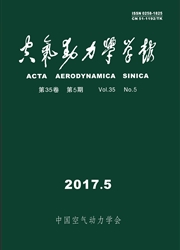

 中文摘要:
中文摘要:
通过数值方法和基于无粘表面流线的工程快速方法,计算了空天飞行器基本型在Ma= 8.0及 Ma= 10. 2 状态下的气动热特性.数值方法计算格式选用Roc的 FDS格式,工程快速方法中飞行器的表面流线是通过基于 直角网格的无粘Euler方程计算得到的,采用参考焓理论沿流线积分即得到沿流线的表面热流分布.结果表明,本 文建立的气动热工程方法及数值方法得到的机身及机翼的热流分布与试验数据吻合较好,得到的驻点热流值与试 验数据的误差小于5%.
 英文摘要:
英文摘要:
Hypersonic aerodynamic heating characteristics fo r an aerospace vehicle at = 8.0 and Ma =10. 2 was calculated by computational fluid dynamics (CFD) method and engineering rapid computational method based on in-viscid surface streamlines. The Roe flux difference scheme(FDS) was employed in the CFD method. For the engineering rapid computational method, the in-viscid surface streamlines were determined by the Euler equations on the Cartesian grid,and the surface heating distribution can be computed by the integration along thein-viscid surface streamlines according to the Eckert reference enthalpy theory. Both laminar and turbulent flows were simulated in the present study. Comparisons were carried out between the engineering rapid computational results, the CFD results, and the experimental results. The results show that the heating distribution can be well predicated fo r the airframe and the wing of the aerospace vehicle by the CFD method and the rapid engineering method developed in thispaper. The error of the aerodynamic heating distribution at the stagnation point is less than 5%.
 同期刊论文项目
同期刊论文项目
 同项目期刊论文
同项目期刊论文
 期刊信息
期刊信息
